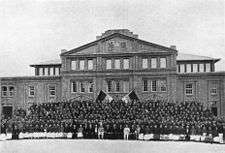National Protection War
| National Protection War | |||||||
|---|---|---|---|---|---|---|---|
| |||||||
| Belligerents | |||||||
|
|
| ||||||
| Commanders and leaders | |||||||
|
|
| ||||||
| Strength | |||||||
| 700,000+ | 200,000+ | ||||||
The National Protection War (simplified Chinese: 护国战争; traditional Chinese: 護國戰爭; pinyin: Hù guó zhànzhēng), also known as the anti-Monarchy War, was a civil war that took place in China from 1915–1916. Only three years earlier the last Chinese dynasty, the Qing Dynasty, had been overthrown and the Republic of China established in its place. The cause of the war was the proclamation by Yuan Shikai, the President of the Republic, of himself as a new Emperor of the Empire of China. In Yunnan province military leaders including Tang Jiyao, Cai E and Li Liejun declared their independence and launched expeditions against Yuan. Yuan's army experienced several defeats and fractured, which led other provinces in the south to declare independence as well. Eventually, under immense pressure from the entire nation, Yuan Shikai was forced to abdicate. He resumed his rule as President and died a few months later.
Origin
After Yuan Shikai plotted the assassination in 1913 of Song Jiaoren, the founder of the Kuomintang, Sun Yat-sen launched the Second Revolution (Chinese: 二次革命) against him. It was unsuccessful, and Sun was forced to flee to Japan while the Kuomintang was dissolved. Between August and December 1915 supporters of Yuan began to clamor for the restoration of a Chinese monarchy. On December 12 Yuan declared himself emperor of the Chinese Empire under the name Hongxian. The new empire was due to formally launch on January 1, when he intended to conduct the accession rites.
Process

Shortly after Yuan proclaimed himself Emperor, military leaders Cai E and Tang Jiyao of Yunnan province declared independence in the provincial capital, Kunming. The date was December 25. They organized the National Protection Army and began an expedition against Yuan's forces. Yuan Shikai sent 80,000 men in an attempt to attack Yunnan, but his troops suffered a major defeat in Sichuan province. Before this defeat, Guizhou and Guangxi provinces declared their independence between February and March 1916. Guangdong, Shandong, Hunan, Shanxi, Jiangxi and Jiangsu followed suit and declared their independence shortly thereafter. Discord began to surface even inside Yuan's government in the national capital of Beijing. Faced with mounting pressure, he was forced to abandon the empire on March 22. He died soon after, on June 6. The National Protection War was proclaimed a success, with the provinces rescinding their declarations of independence.
Northwest China
The Governor of Xinjiang, Yang Zengxin, was a former Qing dynasty official who approved of Yuan Shikai's monarchism and was against republicanism. Yang commanded thousands of Chinese Muslim troops. He ruled Xinjiang with a clique of Yunnanese, being from Yunnan himself. His subordinate Muslim Generals Ma Fuxing and Ma Shaowu were also Yunnanese. When some of the Yunnanese revolutionaries wanted to join Cai E in rebelling against Yang, he beheaded them at a New Year's banquet in 1916. Yang was made a Count by Yuan Shikai.
Influence

The National Protection War symbolized the beginning of the separation between the North and the South after the establishment of the Republic of China. Yuan Shikai was a legitimate president of the Republic, but his attempt to become Emperor was thwarted by the military opposition of the southern provinces. Even after the end of Yuan's short-lived monarchy, the Beiyang government in Beijing was no longer able to maintain control over the military leaders of the southern provinces. After the death of Yuan, the Beiyang government lost its leadership over warlords in the provinces and infighting among cliques within the government began in earnest; meanwhile, Sun Yat-sen of the Kuomintang created a military government in Guangzhou in the far south, leading to the protection of the Constitution.
China's Warlord Era would last for years until Chiang Kai-shek unified the country through the Northern Expedition, the Central Plains War and many other civil wars before the onset of the Second Sino-Japanese War.
References
- Fairbank, John King; Twitchett, Denis (1983). The Cambridge History of China: Republican China 1912–1949, Part 1. Cambridge University Press. ISBN 9780521235419.
- Putnam Weale, Bertram Lenox (1917). The fight for the Republic in China. Dodd, Mead and Company. pp. 490. OCLC 1541271.